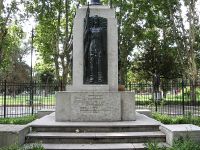Villa Devoto is a neighborhood or district located in the northwestern area of the city of Buenos Aires, Argentina. Its administrative limits are defined by Lope de Vega, General Paz, San Martin, and Francisco Beiro Avenues; and Joaquin V. Gonzalez, Baigorria, and Campana streets.
Villa Devoto, a primarily middle class to upscale neighborhood, is characterized by quiet tree-lined streets and is often considered as The Garden of Buenos Aires. A lower-density, wealthy residential subsection known as Devoto R is located around Arenales Square, in the ward's north-central section.
Villa Devoto is served by the FC Urquiza and FC San Martin commuter railway lines.
History
Part of General San Martin Partido until the Federalization of Buenos Aires, the area was an exurb at the time and was known as Villa Gainza y Lynch. A rail link was built by the Buenos Aires and Pacific Railway, which inaugurated Devoto Station in 1888.
The district was named after Count Antonio Devoto, who became the landowner of most of the present day district in 1904. The Count Devoto was a member of the elite of Buenos Aires. King Victor Emmanuel III of Italy granted Devoto the title of count in 1916 in gratitude for his assistance to the Kingdom of Italy during World War I; Devoto died a few months later.
Devoto owned one of the largest mansions of Buenos Aires, known as Devoto Palace. The mansion was built by Italian architect Juan Antonio Buschiazzo, its 10,000 m² (107,000 ft²) decorated in bronze, silver and gold with ironwork forged in Italy, as well as Florentine mosaics. Prince Umberto di Savoia stayed there during a state visit in 1924. Devoto died before Buschiazzo's work was complete, and the mansion was demolished around 1940. He did not leave any descendants, and his remains lie at the Basilica of San Antonio de Padua in Villa Devoto.
The Metropolitan Seminary of Buenos Aires, alma mater to many of Argentina's bishops and archbishops, was established in
